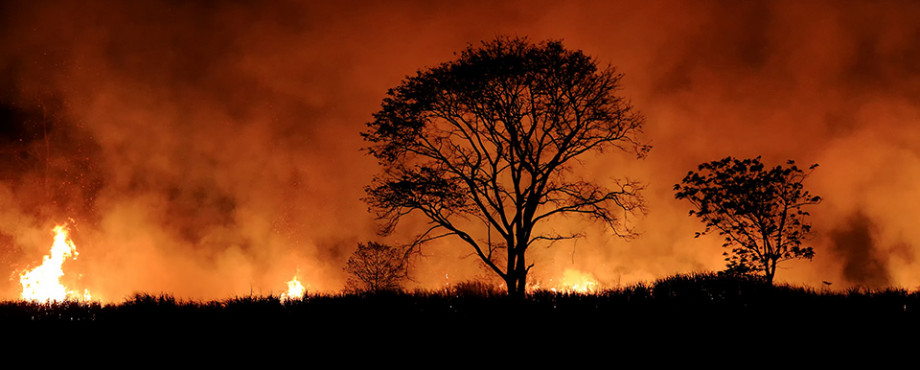
MAJOR POINTS
- Current research aims to predict when and where a catastrophic bushfire will strike.
- Such research would help protect life and property from future extreme bushfires.
- NCI is a critical component of this and other bushfire research.
- The partnership between the UNSW Canberra and NCI spans the better part of a decade.
THE CHALLENGE
The Australian bushfires of 2019/20 were some of the worst in living memory. In total, thirty-three lives were lost. Thousands of homes were destroyed, and the total economic impact is forecast in the order of billions of dollars. Fire ultimately burned through 18.6 million hectares of land, an area more than twice the size of Tasmania. Approximately one billion animals perished in the fires, any many more impacted by habitat destruction. NASA observations measured 300 million tonnes of CO2 emitted during the bushfires, with smoke drifting across the Pacific and reaching as far away as South America.
All fires start small, but some fires grow into large conflagrations that have the potential to cause massive destruction. The majority of damage caused by bushfires is from relatively short episodes as they escalate to ‘extreme bushfires’, involving widespread flaming and dense ember attacks. These fires are so fierce that they create their own miniature weather systems, such as fire-fuelled thunderstorms known as pyrocumulonimbus clouds.
By better understanding the forces and conditions that drive the transition of small fires into raging infernos, researchers hope to be able to better predict the outbreak of massive bushfires before they take place. Such research has significant implications for national security and prosperity, and has the potential to save lives and property.
THE SOLUTION
Bushfire science combines combustion physics and chemistry, ecology and biogeography, meteorology and climate, mathematics, statistics and computational modelling, just to name a few of the dieciplines involved. Professor Jason Sharples (UNSW Canberra) and his team are using sophisticated numerical models and observations to better understand how fires develop into extreme bushfires.
“Our research takes a deeper and more detailed look at the processes that drive bushfire propagation. These processes involve dynamic interactions between the fire and the surrounding environment, which comprises terrain, fuels and weather related factors”, explains Professor Sharples.
“As fires develop into extreme bushfires, the enhanced fire-induced interaction between the boundary layer and the free troposphere produce higher levels of energy, chaos, and nonlinearity.”
Observations of bushfire behaviour, especially those derived from remote-sensing platforms, were an important component of the research. Professor Sharples and his team drew upon observations of unusual fire behaviour during the 2003 Canberra bushfires, as well as coupled numerical weather prediction models and fire spread models. Computational fluid dynamics (CFD) models have also been used to understand interactions between the fire and the atmosphere at a finer scale.
“Based on this, we used the facilities at NCI to examine specific wind-terrain-fire configurations, and were ultimately able to demonstrate the existence of an unknown mode of fire propagation driven by pyrogenic vorticity”, said Professor Sharples.
This finding is just one example of a number of insights delivered by Professor Sharples and his team at UNSW. For the better part of a decade, researchers from UNSW have relied on the computational resources at NCI to study bushfire behaviour. Their key discoveries have included:
- Establishing the existence and conditions required for vorticity-driven lateral spread (VLS) to occur. VLS is a key mechanism in the development of extreme bushfires.
- Studying effect of ignition protocol on the development of quasi-equilibrium fire spread, which is an important consideration in fire experimentation. Some ignition protocols can result in unwanted ‘surging’ behaviour due to pyroconvective dynamics.
- Studying the effect of profile geometry on plume dynamics over inclined trenches, which is important for understanding bushfire behaviour on steep slopes and in canyons. The shape of the trench can influence the angle at which a fire’s plume will attach to the surface.
- Demonstration that the size and geometry of the flaming zone of a bushfire can have a significant effect on whether the fire develops thunderstorm characteristics. This work confirms the role of widespread active flaming in firestorm development.
The models that were used to produce these results are highly computationally intensive, and would not be possible to implement within project timeframes without the Gadi supercomputer.
“The facilities and support at NCI are critically important for the core research of our group,” said Professor Sharples.
“Developing our understanding of the fundamental processes that drive extreme bushfire development requires a dedicated HPC platform that supports the various computational modelling frameworks used by bushfire researchers.”
THE FUTURE
There are many things researchers still don’t understand about dynamic fire propagation and extreme bushfire development. Professor Sharples and his team are continuing to work on better understanding the role of critical fire weather patterns such as troughs, fronts and downslope winds in bushfire escalation, all important components in predicting when and where an extreme bushfire will occur.
Further research into the behaviour of bushfires will aid in the development of improved firefighter training materials, as well as highlight ways that smart urban design can be used to create more bushfire resilient communities.